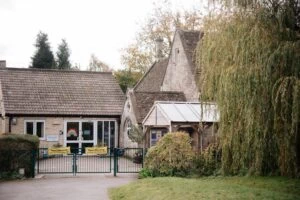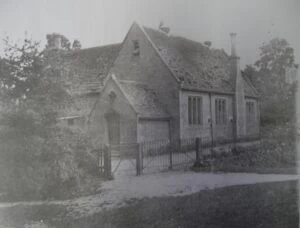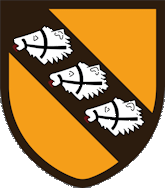School History
Kington St Michael with Langley tithing had a school for ten pupils in 1818. The teacher’s salary was paid yearly by the Governors of Christ’s Hospital. Between this date and the opening of the National School there were 50 young children attending four dame schools and a Sunday school had 60 pupils. 
One of these dame schools was in the upper room of a granary at ‘Limes Farm’. The National School was built in 1856/7 with aid from the Committee of the Parish Council. Her Majesty’s Inspector of Schools described it in 1858 as having “Two very fair rooms, board floors, desks parallel. 50-60 children, mixed, taught under a mistress”. 
Mr Clutterbuck was actively involved in the erection of the church and school house. He died in 1861 aged 36. A memorial window dedicated to him was erected in the church. In 1863 there were 42 children in the day school. The school was enlarged in 1886 for 95 scholars and the average attendance in 1895 and 1907 was 80.
There were on average 74 pupils attending in 1889. In 1885 the mistress was Miss Sarah Jane Coombs. She had become Mrs Sarah Little by 1895 and continued as mistress until at least 1903. By 1919 there were around 90 pupils with one head teacher, one teacher for the seniors and one for the infants. In 1923 the HM Inspector reported that the classroom was inadequately furnished and it was necessary to stop using it.
The ceiling of the cloakroom was in a dilapidated condition.
The school log books for Kington Langley only survive from the 1920s, although diaries of the Reverend Daniells, a Vicar in the Victorian period survived and were used to compile a history of Kington Langley by the Reverend Meers, published in the 1950s. Many aspects of school life noted in the 1920s had also existed in Victorian times. Classes were centred around reading, writing, arithmetic and religious instruction. ‘Oral studies’ were also important and were based around rote learning which included singing songs and rhymes.
The infants learnt to write on sand or slate boards. Sums were done on bead frames. The older boys learnt drawing (in 1920 the Reverend Clarke gave instruction in this) and the girls had needlework. There was also history and geography. In the 1920s there were visits by other teachers; in March 1920 an instructress in PE came to visit, in October 1923 an American schoolmaster visiting England gave a lesson in Decimals to the senior class. In March 1927 a ‘Miss Garnett’ gave a talk to the older children on her trip to Greece, which included photographs! In April 1927 a visitor from Chippenham gave a talk on Beethoven which was illustrated by compositions on a gramophone. The lecture was reproduced afterwards by the children. The visitor also came back to do a similar talk on Schubert – the first talk must have been well received. This time the children learned to sing two songs which were recorded so they could enter the Columbia Record Company Competition in connection with the Schubert Centenary. After school the children would play with hoops, marbles, skipping ropes and spinning tops.
All schools from the late 19th century onwards were assessed by Her Majesty’s Inspectors for schools. They produced a report which was written in the school log book. In 1867 a school inspection told that “All elder children failed in arithmetic and writing. Inspector praised order of school – a kind and careful examination”. In October 1920 the report noted “Infants under careful instruction and answered very encouragingly. Older children write with great neatness and good expression. They were thoroughly well acquainted with the subjects and responded brightly to the questions asked”. There were also Diocesan Inspectors who visited the school purely to report on religious instruction. In October 1920 the Diocesan report noted “The changes of stay have unsettled the school a little, especially with regard to the infants. The older children shewed keenness and confidence in their subjects and answered well. Their essays on scriptural character were decidedly well done and the general tone of the school is pleasing”. The change in staffing at the school must have had a more long term effect on the children as in May 1923 the HMI report showed that things had changed. Thirty seven older children were taught by the head mistress and 28 were taught by uncertified and supplementary teachers. The report classed standards as ‘unsatisfactory’ with no pre-planning work conducted. The classes were ‘not begun promptly or in a business like manner. Order is good’.
Holidays were similar to our own, with two weeks for Christmas, two at Easter, one at Whitsun, but there were only four weeks for summer or ‘Harvest’ holidays. Time off was given for special days such as Ash Wednesday and Ascension Day in May and in 1922 for Princess Mary’s wedding. Children were also allowed time off when the schoolroom was needed for other purposes, for example as a Polling Station for the General Election. On another occasion all teaching staff attended a demonstration of PE being held in Chippenham. Physical education by ‘drill’ was an important part of the school curriculum from the turn of the 20th century.
Days out seem to be quite common for schoolchildren in the 1920s; they went to visit Wembley, Clifton Zoo and Burnham-on-Sea. This also happened in the late 19th Century but only once a year, and not by charabanc as they did in the 1920s! They probably went by wagon as the 80 children who intended the children’s feast in Draycot did in July 1866. There were heavy showers on the way. The grass was so wet they came home again and tried again the following day. There were only showers but even so two gallons of milk had been ruined. The cake must have been O.K. though because they took 80 pounds weight and only one cake came back! Sunday school outings were also held once a year. In April 1922 fifteen children took part in the Devizes Folk Dancing Competition. Sometimes the children took days off when they shouldn’t, usually to attend a market, flower show or the village fete, as happened in December 1919 when children went to Chippenham Market. In August 1920 the children got so wet at the Chippenham Flower Show they were absent again from the school the following day! May 21st was Empire Day when, at 2.45pm, children marched through the village, sang Empire songs and saluted the Union Jack. There was a procession of flags to the Church gate. A Union Jack was hoisted and the National Anthem sung. Recitations were given later by the Vicar on the duties of Citizenship.
The weather also played a part in keeping the children away from school. They all had to walk to school, sometimes quite a distance, and they often had poorly fitting and well worn boots. Studs were often put in the heels and toes of boots to make them last longer and the boots were rubbed with ‘shoe oil’ to soften them but children’s feet were often very sore. The children were often were soaked through by the time they got to school in wet weather and there was only a small stove to use to dry out. In May 1859 two children were sent away for being improperly dressed, possibly because their parents could not afford to buy suitable clothes for them, for example stout boots and pinafores for the girls. Many children were kept away from school in wet weather so as not to catch colds which could lead to more serious health problems. In April 1922 there was such a snow storm that the class register was not taken, there were so few present. There was an unexpected event on July 20th 1859 when a hailstorm was so violent it smashed windows and blew down trees in the village. Some hailstones weighed over 1oz! Children were also required to help their parents in the fields at certain times of the year. In April 1867 several of the elder children were missing, planting potatoes. June was the haymaking season and autumn, potato picking.
There were many diseases prevalent in Victorian times and, if the records of the early to mid twentieth century are anything to go by, the school was particularly badly hit by them. In 1858 there was a diphtheria outbreak during which nine children died in three months. The school was closed by the Medical Officer in June 1920 (for diphtheria), November 1920 (for measles), February 1921 (for influenza). There were outbreaks of mumps in 1922 and measles and colds in 1923, and the school was closed again in December 1924 for whooping cough. In 1924 there was also impetigo, 1926 saw chickenpox. In 1927 the school was closed again by influenza. In 1929 there was scarlet fever which left four scholars in hospital. In 1931 measles was back and the teacher noted that even when the children were able to come to school they were ‘far from well’. In 1934 there was whooping cough again… No wonder parents kept their children away from school on particularly wet days!
The children were inspected by a nurse who weighed them, measured them and checked for head lice. In January 1920 a girl was excluded until further notice due to a “verminous head”. A dentist visited the school too.
Discipline was very much impressed on the school children throughout the late nineteenth and into the twentieth century. In February 1860 a boy was dismissed for ‘insolence’ and ‘disobedience’. In 1865 a boy was hurt by a stone thrown by another boy. This boy was ‘reprimanded and spoken to on the evil of throwing stones’ but it was also noted by the Vicar that he though the assistant teacher was ‘too noisy and harsh’ in telling off the boy! In June 1922 a boy in the Standard IV class, ‘having been rebuked for impertinence by the head teacher, and also for using threatening language, was dismissed to the porch. He went home and returned in the afternoon session – the head teacher requested him to leave the school, until adequate apology has been made, to her, and contrition expressed. This boy has given much trouble, and is a shocking example of insubordination’. In September 1932 corporal punishment was given to a boy for ‘persistent insubordination covering a period of weeks and for impertinence. At 11o’clock after recreation he was found to have gone home’. The school log books do not mention bad behaviour often, so on the whole the children must have been quite well behaved.
The children also received treats for good behaviour too. Sarah Bowerman left money for prizes for the children of Kington Langley and Kington St Michael School in 1899. In December 1923 Mr and Mrs Garnett of Great House presented each child with sixpence as a Christmas gift. There was a school feast reported in 1858 which was an annual event. ‘After the church service the children got flags and walked to Miss Salter’s for tea. The children had too much bread and butter (they should have had the cake first). There were races for balls, marbles and dancing. The boys running after the balloons frightened Mrs Lane’s cows. One was much hurt by the fighting’ (Reverend Daniells does not explain if he meant a boy or a cow!). The children for many years had tea at the Vicarage in the summer, as in July 1867 when there were flags around the fence, five swings erected in the grounds. A fire balloon went up ‘nicely’ and was recovered. These may well have been the same type of balloons that frightened the cows nine years earlier, so no wonder it was mentioned they were set off nicely! In 1858 there was a girls’ tea party held by the vicar which was also an annual event. The boys had tea in 1860 but it does not mention if this was done annually too.
By 1931 the National School had only 43 pupils. One of the uncertified assistants left and would not be replaced because of the low numbers of children attending. From 1940 the older children went to Chippenham for secondary schooling. By 1955 there were even fewer children attending and the voluntary controlled school had only 36 pupils. In 1998 the Langley Fitzurse Church of England voluntary controlled primary school had 100 pupils with 4 qualified teachers and 4 support staff. This number rose to a maximum of 118 by 2007. The school currently has 94 pupils.
In 2004, a new school hall was built, named Cherry Hall after the last tree planted in the grounds – a cherry tree to honour Mrs Margaret Tapper, who had been School Secretary for many years.
In November 2020, Langley Fitzurse C of E Primary School federated with Stanton St Quintin Primary School to ensure a bright future for both establishments.
Legend has it that the school name derives from Reginald Fitzurse, one of the knights who murdered St Thomas A Becket at Canterbury Cathedral on 29 December 1170, and who held land in the village.

